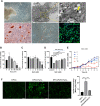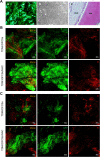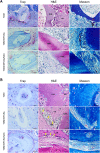Improvement of ECM-based bioroot regeneration via N-acetylcysteine-induced antioxidative effects
- PMID: 33752756
- PMCID: PMC7986250
- DOI: 10.1186/s13287-021-02237-5
Improvement of ECM-based bioroot regeneration via N-acetylcysteine-induced antioxidative effects
Abstract
Background: The low survival rate or dysfunction of extracellular matrix (ECM)-based engineered organs caused by the adverse effects of unfavourable local microenvironments on seed cell viability and stemness, especially the effects of excessive reactive oxygen species (ROS), prompted us to examine the importance of controlling oxidative damage for tissue transplantation and regeneration. We sought to improve the tolerance of seed cells to the transplant microenvironment via antioxidant pathways, thus promoting transplant efficiency and achieving better tissue regeneration.
Methods: We improved the antioxidative properties of ECM-based bioroots with higher glutathione contents in dental follicle stem cells (DFCs) by pretreating cells or loading scaffolds with the antioxidant NAC. Additionally, we developed an in situ rat alveolar fossa implantation model to evaluate the long-term therapeutic effects of NAC in bioroot transplantation.
Results: The results showed that NAC decreased H2O2-induced cellular damage and maintained the differentiation potential of DFCs. The transplantation experiments further verified that NAC protected the biological properties of DFCs by repressing replacement resorption or ankylosis, thus facilitating bioroot regeneration.
Conclusions: The following findings suggest that NAC could significantly protect stem cell viability and stemness during oxidative stress and exert better and prolonged effects in bioroot intragrafts.
Keywords: Bioroot regeneration; Dental follicle stem cell; N-Acetylcysteine; Oxidative stress; Treated dentin matrix.
Conflict of interest statement
The authors declare that they have no competing interests.
Figures





Similar articles
-
PPAR-γ activation promotes xenogenic bioroot regeneration by attenuating the xenograft induced-oxidative stress.Int J Oral Sci. 2023 Feb 16;15(1):10. doi: 10.1038/s41368-023-00217-4. Int J Oral Sci. 2023. PMID: 36797252 Free PMC article.
-
N-acetylcysteine regulates dental follicle stem cell osteogenesis and alveolar bone repair via ROS scavenging.Stem Cell Res Ther. 2022 Sep 8;13(1):466. doi: 10.1186/s13287-022-03161-y. Stem Cell Res Ther. 2022. PMID: 36076278 Free PMC article.
-
Preconditioning of bone marrow-derived mesenchymal stem cells with N-acetyl-L-cysteine enhances bone regeneration via reinforced resistance to oxidative stress.Biomaterials. 2018 Dec;185:25-38. doi: 10.1016/j.biomaterials.2018.08.055. Epub 2018 Sep 4. Biomaterials. 2018. PMID: 30216807
-
Existing and potential therapeutic uses for N-acetylcysteine: the need for conversion to intracellular glutathione for antioxidant benefits.Pharmacol Ther. 2014 Feb;141(2):150-9. doi: 10.1016/j.pharmthera.2013.09.006. Epub 2013 Sep 28. Pharmacol Ther. 2014. PMID: 24080471 Review.
-
A minireview on N-acetylcysteine: An old drug with new approaches.Life Sci. 2016 Apr 15;151:359-363. doi: 10.1016/j.lfs.2016.03.003. Epub 2016 Mar 2. Life Sci. 2016. PMID: 26946308 Review.
Cited by
-
Tebuconazole Induces Mouse Fetal Testes Damage via ROS Generation in an Organ Culture Method.Int J Mol Sci. 2024 Jun 27;25(13):7050. doi: 10.3390/ijms25137050. Int J Mol Sci. 2024. PMID: 39000159 Free PMC article.
-
PPAR-γ activation promotes xenogenic bioroot regeneration by attenuating the xenograft induced-oxidative stress.Int J Oral Sci. 2023 Feb 16;15(1):10. doi: 10.1038/s41368-023-00217-4. Int J Oral Sci. 2023. PMID: 36797252 Free PMC article.
-
Evaluation of Current Studies to Elucidate Processes in Dental Follicle Cells Driving Osteogenic Differentiation.Biomedicines. 2023 Oct 13;11(10):2787. doi: 10.3390/biomedicines11102787. Biomedicines. 2023. PMID: 37893160 Free PMC article. Review.
-
Treated Dentin Matrix in Tissue Regeneration: Recent Advances.Pharmaceutics. 2022 Dec 27;15(1):91. doi: 10.3390/pharmaceutics15010091. Pharmaceutics. 2022. PMID: 36678720 Free PMC article. Review.
-
N-acetylcysteine regulates dental follicle stem cell osteogenesis and alveolar bone repair via ROS scavenging.Stem Cell Res Ther. 2022 Sep 8;13(1):466. doi: 10.1186/s13287-022-03161-y. Stem Cell Res Ther. 2022. PMID: 36076278 Free PMC article.
References
Publication types
MeSH terms
Substances
LinkOut - more resources
Full Text Sources
Other Literature Sources
Medical

